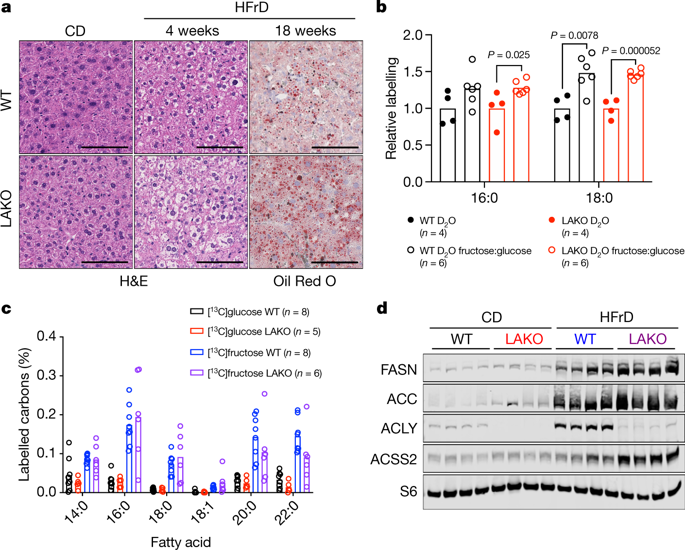Nature ( IF 64.8 ) Pub Date : 2020-03-18 , DOI: 10.1038/s41586-020-2101-7 Steven Zhao 1, 2, 3 , Cholsoon Jang 4 , Joyce Liu 1, 2, 5 , Kahealani Uehara 5, 6, 7 , Michael Gilbert 1, 2, 5 , Luke Izzo 1, 2, 3 , Xianfeng Zeng 4 , Sophie Trefely 1, 2, 8 , Sully Fernandez 1, 2 , Alessandro Carrer 1, 2, 9 , Katelyn D Miller 10 , Zachary T Schug 10 , Nathaniel W Snyder 8 , Terence P Gade 1, 11 , Paul M Titchenell 6, 7 , Joshua D Rabinowitz 4 , Kathryn E Wellen 1, 2, 7

|
Consumption of fructose has risen markedly in recent decades owing to the use of sucrose and high-fructose corn syrup in beverages and processed foods1, and this has contributed to increasing rates of obesity and non-alcoholic fatty liver disease2,3,4. Fructose intake triggers de novo lipogenesis in the liver4,5,6, in which carbon precursors of acetyl-CoA are converted into fatty acids. The ATP citrate lyase (ACLY) enzyme cleaves cytosolic citrate to generate acetyl-CoA, and is upregulated after consumption of carbohydrates7. Clinical trials are currently pursuing the inhibition of ACLY as a treatment for metabolic diseases8. However, the route from dietary fructose to hepatic acetyl-CoA and lipids remains unknown. Here, using in vivo isotope tracing, we show that liver-specific deletion of Acly in mice is unable to suppress fructose-induced lipogenesis. Dietary fructose is converted to acetate by the gut microbiota9, and this supplies lipogenic acetyl-CoA independently of ACLY10. Depletion of the microbiota or silencing of hepatic ACSS2, which generates acetyl-CoA from acetate, potently suppresses the conversion of bolus fructose into hepatic acetyl-CoA and fatty acids. When fructose is consumed more gradually to facilitate its absorption in the small intestine, both citrate cleavage in hepatocytes and microorganism-derived acetate contribute to lipogenesis. By contrast, the lipogenic transcriptional program is activated in response to fructose in a manner that is independent of acetyl-CoA metabolism. These data reveal a two-pronged mechanism that regulates hepatic lipogenesis, in which fructolysis within hepatocytes provides a signal to promote the expression of lipogenic genes, and the generation of microbial acetate feeds lipogenic pools of acetyl-CoA.
中文翻译:

膳食果糖通过微生物群衍生的乙酸盐促进肝脏脂肪生成
近几十年来,由于饮料和加工食品中使用蔗糖和高果糖玉米糖浆1,果糖的消费量显着增加,这导致肥胖和非酒精性脂肪肝发病率增加2,3,4。果糖摄入会触发肝脏中的从头脂肪生成4,5,6,其中乙酰辅酶A的碳前体转化为脂肪酸。ATP 柠檬酸裂解酶 (ACLY) 裂解胞质柠檬酸生成乙酰辅酶 A,并在消耗碳水化合物后上调7。目前临床试验正在探索抑制 ACLY 作为代谢疾病的治疗方法8。然而,从膳食果糖到肝脏乙酰辅酶A和脂质的途径仍然未知。在这里,利用体内同位素示踪,我们发现小鼠肝脏特异性删除Acly无法抑制果糖诱导的脂肪生成。膳食果糖被肠道微生物群转化为乙酸盐9,并且这独立于 ACLY 10提供脂肪生成乙酰辅酶A。微生物群的耗竭或肝脏 ACSS2(从乙酸盐生成乙酰辅酶A)的沉默,可有效抑制大剂量果糖转化为肝乙酰辅酶A和脂肪酸。当果糖逐渐被消耗以促进其在小肠中的吸收时,肝细胞中的柠檬酸盐裂解和微生物衍生的乙酸盐都有助于脂肪生成。相比之下,脂肪生成转录程序以独立于乙酰辅酶A代谢的方式响应果糖而被激活。这些数据揭示了调节肝脏脂肪生成的双管齐下的机制,其中肝细胞内的果糖分解提供了促进脂肪生成基因表达的信号,并且微生物乙酸盐的产生为乙酰辅酶A的脂肪生成池提供营养。


























 京公网安备 11010802027423号
京公网安备 11010802027423号